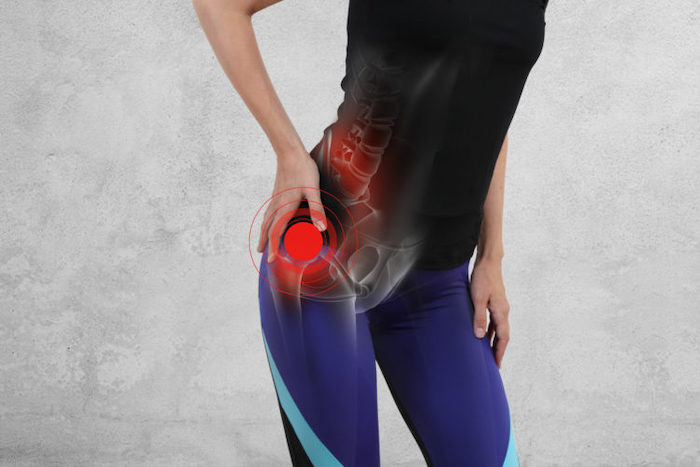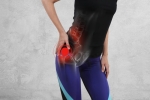
The sharp, searing pain and numbing symptoms of piriformis syndrome often flare during the day with simple activities such as sitting, walking, driving, or lying down to sleep. If left untreated or ignored, these ongoing symptoms can worsen over time, resulting in chronicity and pain lasting up to 2 years in some individuals.
Being mindful of your posture and engaging in simple piriformis exercises, such as walking or piriformis stretches, can provide meaningful relief from piriformis syndrome pain.
This blog discusses effective self-care remedies that help control the symptoms of piriformis syndrome in routine day-to-day activities.
How To Sit With Piriformis Syndrome To Minimize Tension And Pain
Sitting applies direct pressure on the piriformis muscle in the buttock, and the inability to sit for a long period is a classic symptom of piriformis syndrome.
Piriformis muscle pain while sitting may be relieved by following these tips:
- Sit with a neutral, upright spine and avoid slumping or bending forward to help distribute weights evenly through the spine and across the pelvis.
- Ensure your feet are flat on the ground and your thighs are parallel to the floor.
- Use a footstool, if needed, to elevate the feet and reduce pressure on the pelvis and legs.
- Adjust the armrest of your chair so that it just slightly lifts your arms at the shoulders and helps take the strain off the shoulder and upper back.
- Place a rolled-up towel or lumbar support cushion to help maintain the arch in the lower back and prevent slumping forward.
- Avoid sitting in a cross-legged position, which may further irritate the piriformis muscle and sciatic nerve.
In general, if you have piriformis muscle pain, avoid sitting for long periods and take short walks or alternate between sitting and standing, if possible.
Driving Tips To Minimize Piriformis Syndrome Pain
Driving may flare piriformis muscle pain in the buttock due to a constant seated position. Additionally, leg movements to use the pedal may worsen the symptoms in the buttock and leg, especially when the drive is long.
Here is a list of useful tips to help relieve piriformis syndrome pain while driving:
- Keep your left foot on the rubber pedal throughout the drive. This position ensures that your legs are positioned symmetrically, and your pelvis is balanced equally on both sides.
- Find the right distance between the seat and the pedal to prevent your leg from being extended too much or too little.
- Use a heat pack on the affected side while driving. Heat therapy can help calm the muscle fibers and soothe the sacral area of the lower spine, preventing piriformis muscle pain from flaring.
For ongoing piriformis muscle pain, consider applying topical pain medication such as a pain-relieving gel or cream over the affected side and gently massaging the area to soothe the muscle and prevent it from becoming painful during the drive.
Sleeping Better With Piriformis Syndrome
Lying down can place pressure on both the piriformis muscle and the sciatic nerve. Consider the following tips to help prevent piriformis syndrome pain while lying down and promote better sleep at night:
- Use a heat pack for 10-20 minutes on the affected side before sleeping to help soothe the muscle and soft tissues, preventing a flare-up of pain at night.
- Elevate your knees using a pillow if you’re a back sleeper.
- Place a pillow between your legs if you’re a side sleeper.
- Invest in a good-quality, medium-firm mattress for optimal spinal support. Research suggests that using a medium-firm mattress may help reduce lower back pain.
In general, avoid sleeping on your stomach. This position disturbs the spine's normal alignment and may aggravate musculoskeletal pain.
Walking Tips To Reduce Piriformis Syndrome Pain
It is common for people to wonder if walking is good for piriformis syndrome pain or makes the condition worse. The answer to this question lies in how your symptoms are affected while walking.
- If walking helps relieve your piriformis muscle pain, take a few long walks or multiple short walks throughout the day.
- If walking neither improves nor worsens your piriformis muscle pain, take as many tolerable short walks as possible throughout the day.
- If walking worsens your piriformis muscle pain, take 3 to 4 small walking breaks throughout the day that range from 30 seconds to a minute.
The goal is to keep moving, which helps maintain back mobility, prevent stiffness, and promote the body’s natural healing processes. If walking is not possible, try a recumbent bike, which is more comfortable and provides the benefits of walking.
Quick One-Minute Stretch To Relieve Piriformis Muscle Pain
A quick and effective way to relieve piriformis muscle pain is to stretch the muscle. The following stretches are easy to perform and depending on your convenience and location, you can choose the sitting stretch or standing stretch.
Sitting Piriformis Muscle Stretch - For a sitting piriformis stretch, you’ll need to:
- Sit comfortably on a chair with your feet flat on the ground and thighs parallel to the floor.
- Cross your right leg over the left with the right ankle over the edge of the left thigh.
- Keep your back straight and your hands on your waist.
- Gently fold forward at your waist without bending the back until a stretch is felt in the right buttock.
Hold the stretch for 10 seconds; repeat the exercise 3 times. Switch to crossing the left leg over the right and repeat 3 times.
Standing Piriformis Muscle Stretch - For a standing piriformis stretch, you’ll need to:
- Stand near a chair or table.
- Hold the chair or table with your right hand for support and bring your right ankle over your left knee.
- Hold the ankle with your left hand and gently bend forward at your waist without curving your back until a stretch is felt in the right buttock.
Hold the stretch for 10 seconds; repeat the exercise 3 times. Switch to the opposite side and repeat 3 times.
Try a combination of these tips to see what works best to relieve your piriformis muscle pain. If your pain gets worse and/or considerably disrupts your daily life, check with your doctor about additional pain relief options, which may include medications, guided physical therapy, piriformis injection treatments, and more.
Precision Pain Care and Rehabilitation has two convenient locations in Richmond Hill – Queens, and New Hyde Park – Long Island. Call the Queens office at (718) 215-1888 or (516) 419-4480 for the Long Island office to arrange an appointment with our Interventional Pain Management Specialist, Dr. Jeffrey Chacko.













